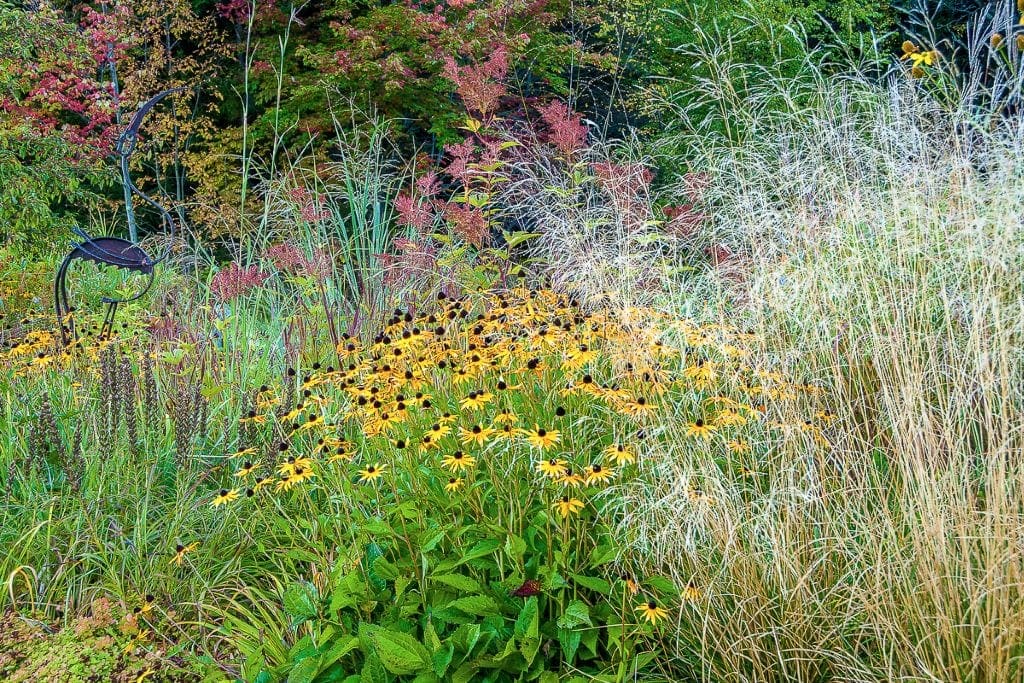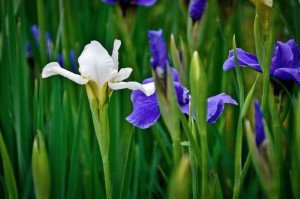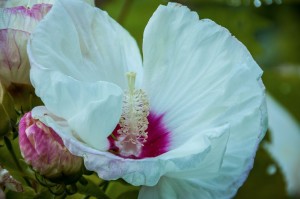A little bit of meadow
I love our pond bed. You can see it from the house as well as from much of the back garden, and all season long it overflows with vibrant perennials and grasses and it feels like it has been here for ever.
But in reality it only came into being about a decade ago and, along the way, its creation involved rerouting a moose, overcoming weeds, building the soil and choosing appropriate plants for this particular situation.
A dominate presence in the garden
Today I cannot imagine the garden without the pond bed. It sits at the far end of our long back lawn, and acts as a visual bridge between the beds along either side, pulling everything into a single cohesive picture.
The mix of plants, many of pasture or prairie origin, make it more reminiscent of a meadow than a formal garden bed. As such it creates as a gentle transition from the orderliness within the garden to the wild areas beyond.
And it looks stunning when cross-lit with low sunlight: especially nice as we sip our morning coffee (in bed), and as again as we sip our evening wine (in the gazebo).

The pond bed is a dominate presence in the garden, as it glows in the low sun.
With a relaxed mix of plants it creates a gentle transition from garden formality to the wild outside.
Inauspicious beginnings
Early on in the life of our Vermont garden I gave no thought to doing anything that would obscure the view of the little spring-fed pond at the far end of the lawn.
We had gotten used to the fact that, towards the end of summer the height of the water in the pond might drop by a foot or so (because of a corresponding drop in the water-table that feeds the springs below the pond). Each October, as soon as the leaves are off the trees, the water-table rises and it just takes a week or so for the pond to come back to its full height.
Then one August about twelve years ago the pond went completely dry, and for two months we stared at a big hole in the ground!!
So I began to contemplate the idea of adding ‘something’ to hide this situation which I was sure would recur in particularly dry summers.
The following spring a mother moose began visiting the pond on a regular basis, bringing a pair of calves with her. She would spend half an hour cooling off in the water and then lead her offspring right up the middle of the lawn, past the house and parked cars, down the road, and across the meadow to the beaver swamp over the hill. And while some of our B&B guests were enthralled to see such a huge animal while they munched their breakfast, others were horrified as she and her brood strolled nonchalantly past their cars.
That did it! I decided to install a thirty foot span of split-rail fence across the south edge of the pond, hoping to nudge her into leaving via the west side of the pond, a route which would take her directly into the meadow.
The fence was indeed successful. For several more years she returned with her new family to cool off in the pond, but then took the direct route across the road to the meadow!
Adding a bed
After this it was but a small step for me to add a bed in front of the fence. I figured it would hide the problem of the ‘hole in the ground’ during future dry summers and maybe also further deter the moose.
Improving the soil
I knew from the outset that I would be fighting the pernicious Horsetail weed as well as the grasses that live around the edge of the pond. Horsetail is an ancient weed that thrives in poor waterlogged soil with low oxygen levels. It can be deterred (but not eliminated) by improving the drainage and fertility and aerating the soil to increase the oxygen content.
So I started by building up the level of the soil to well above the high-water level of the pond, and building a rough two-foot high retaining wall behind the fence to hold everything in. And a few years later my friend Tammy Walsh added a nicer and lower wall around the front side of the bed. This all ensures the soil in the bed is well above the water in the pond, giving me in a moist but not water-logged growing space.
After this I spent a goodly amount of time with my garden fork chasing down every last weed root that was lurking in the top 18 inches of soil, and digging in copious amounts of compost to lighten the heaviness.
Choosing the best plants for the situation
Other than one crab apple set on higher ground at the west end, I populated the entire bed with larger-growing perennials, using a closer then normal spacing. My goal was to ensure that, as everything grew in, the soil would be fully shaded by my plants, thus making it more difficult for the weeds to return.
I chose tried-and-true perennials with robust personalities that would provide strong color and interesting leaves throughout the season. In flowering sequence these include:
Purple and white Siberian iris
Japanese Iris, Iris ensata
Creamy white Rodgersia aesculifolia with its crinkly leaves and
creamy white plumes that later turn pink
Bright white Shasta daisies, Leucanthemum ‘Becky’
Daylilies in various shades of yellow and red,
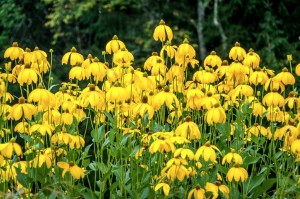
The lovely clear yellow flowers of Rudbeckia ‘Herbstonne’ or ‘Autumn Sun’ are about seven feet high, and like the tall grasses, they dance in the wind.
Plenty of purple spiky Liatris, including some of the shorter cultivar ‘Kobold’ for the front of the bed
Pink meadowsweet, both the very tall Filipendula rubra as well as the delightful small F. ‘Kahome’ for the front of the bed.
Rudbeckia ‘Herbstonne’ for the very back of the bed and Rudbeckia ‘Goldstrum’ for the middle and front.
Some Veronicratsum with its tall white spires in summer
And more tall white spires in fall with the bugbane, Actea simplex ‘Hillside Beauty’
And last but not least, three Swamp Rose Mallow, Hibiscus moscheutos for their huge flowers, white and red.

This grass, between the yellow daylilies and the purple spikes of Liatris,is Deschampsia. It stays like this from June to October.
To integrate and soften the whole picture I also incorporated plenty of airy but tough grasses, including Deschampsia cespitosa, Panicum ‘Shenandoah’ and ‘P. ‘Dallas Blues’. And for some back of the border heft a couple of Miscanthus: the tall M. ‘Malepartus’ for its plummy colored flowers, and the slightly shorter m. ‘Purpurascens’ for its lovely yellow-bronze leaves in the fall.
Results
The results have been astoundingly successful. No more hole in the ground during a dry summer! Instead we enjoy an ever-changing tapestry of colors that we can see even from the house, while the grasses add texture and movement, bringing the whole picture alive.

At mid-summer the Liatris and daylilies dominate, but the Black-eyed Susans are already starting to flower.
AND, after a few years of watchful weeding as the new perennials grew in, the horsetail and other weeds are barely apparent. Horsetail in particular needs heavy acidic soil and decent light conditions to thrive. Deprive it of these things and, given time, it will essentially disappear!
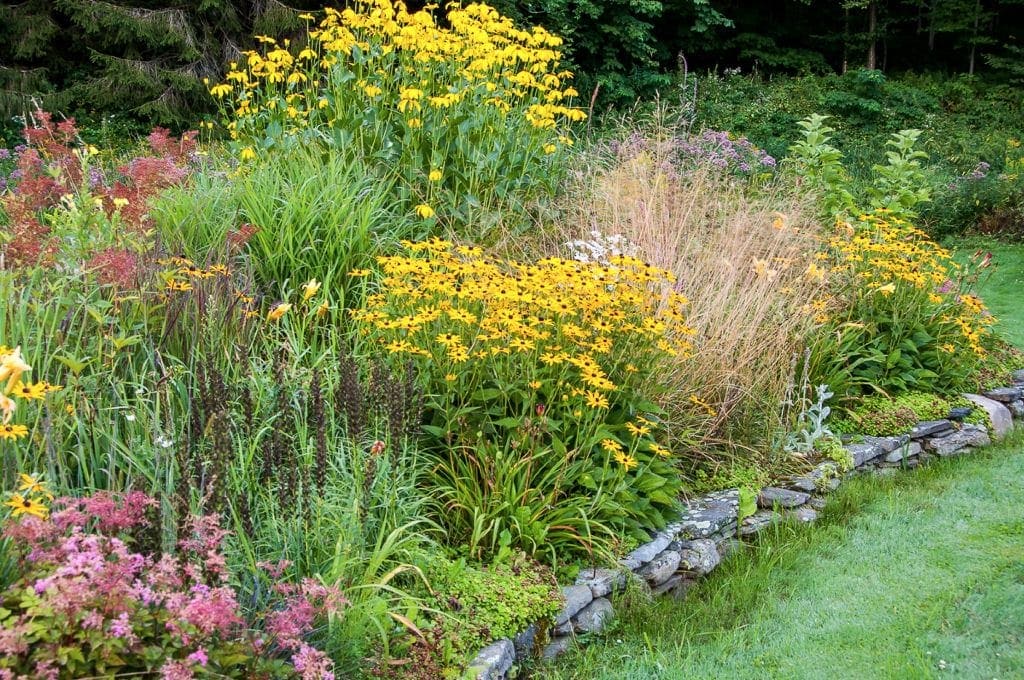
The pond bed in mid-August:
Two pink Filipendula: F. ‘Kakome’ in the front and F. rubra behind
And two yellow Rudbeckia: R. ‘Goldstrum in the center and Rudbeckia ‘Herbstonne’ at the rear
Tweaking the design
While I love the pond bed, it could use some new colors as the season wanes.
There is, of course, plenty of yellow, provided by the masses of Black-eyed Susans (Rudbeckia ‘Goldstrum’) and the taller Rudbeckia ‘Herbstonne. And there are also flowering grasses like Panicum ‘Shenandoah’ that turn color, as well as many handsome seed-heads of the perennials, notably the Filpendula, Rodgersia and Liatrus.
But I still feel something is needed to counterbalance the brashness of the Black-eyed Susans.
So later this fall I will be adding a few lilac-colored flowers as end-of-season highlights.
I will make use of plants growing elsewhere in the garden. I have my eye on taking some divisions of some of the airy Aster ‘October Skies’ and a few of the sturdy New England Asters, and possibly some deep pink Phlox ‘Robert Poore’.
And finally I plan on popping a couple of the long flowering Geranium ‘Rozanne’ into the front to complete the picture.
While these changes may be small, I think they will give the end-of-season bed a whole new look.

